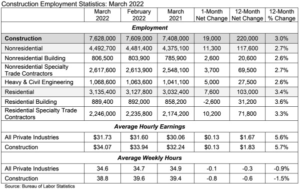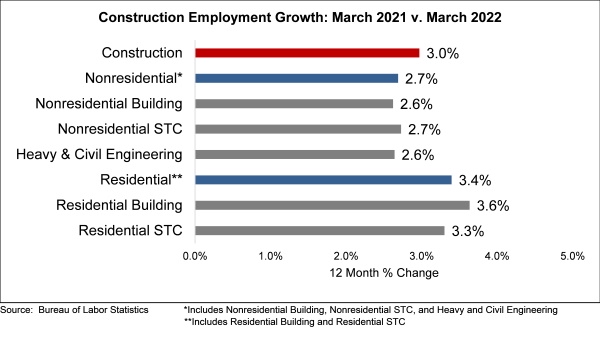The construction industry added 19,000 jobs on net in March, according to an Associated Builders and Contractors (ABC) analysis of data released on April 1 by the U.S. Bureau of Labor Statistics. After 23 months of recovery, construction employment has at last exceeded pre-pandemic levels. On a year-over-year basis, industry employment has expanded by 220,000 jobs, an increase of 3.0%.
Nonresidential construction employment expanded by 11,300 positions on net, with all three subsectors generating growth. Heavy and civil engineering added 5,000 net new jobs. Nonresidential specialty trade contractors added 3,700 positions. Nonresidential building added 2,600 jobs.
The construction unemployment rate fell to 6.0% in March. Unemployment across all industries declined from 3.8% in February to 3.6% last month.
 “Contractors continue to signal that they are searching far and wide for additional workers,” said ABC chief economist Anirban Basu. “With more workers reentering the labor market, job openings continue to translate into employment growth. Given elevated backlog and the expectation that demand for services will remain high, according to ABC’s Construction Backlog Indicator, construction employment is poised to grow further this year.
“Contractors continue to signal that they are searching far and wide for additional workers,” said ABC chief economist Anirban Basu. “With more workers reentering the labor market, job openings continue to translate into employment growth. Given elevated backlog and the expectation that demand for services will remain high, according to ABC’s Construction Backlog Indicator, construction employment is poised to grow further this year.
“Interestingly, the unemployment rate for construction workers is well above the economywide rate,” said Basu. “This is at odds with the notion of a severe worker shortage facing construction. The issue relates to skill sets. While many refer to the current circumstances as a labor or worker shortage, it is perhaps more properly characterized as a skills shortage.
“With infrastructure spending set to rise and construction workers retiring at a rapid rate, skills shortages are likely to worsen going forward,” said Basu. “That translates into rapid wage growth. Given high and rising materials prices, project owners will continue to see elevated bids for construction service delivery, although how this will affect project postponements and cancellations remains unclear.”














